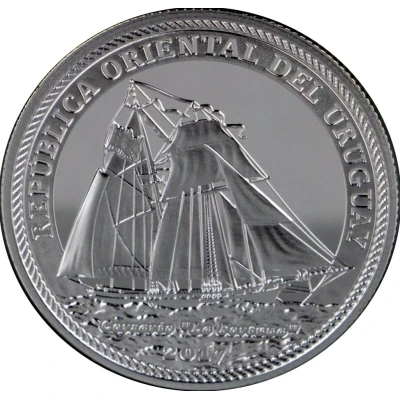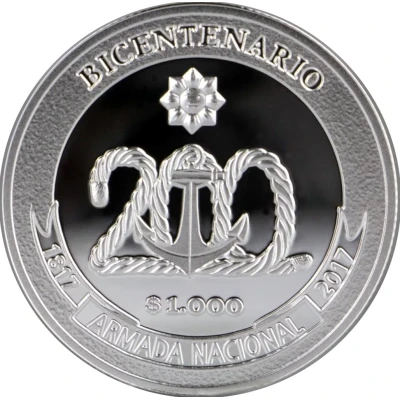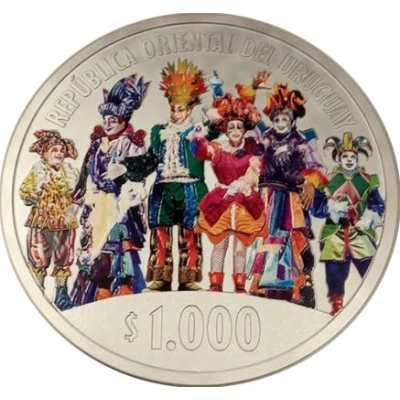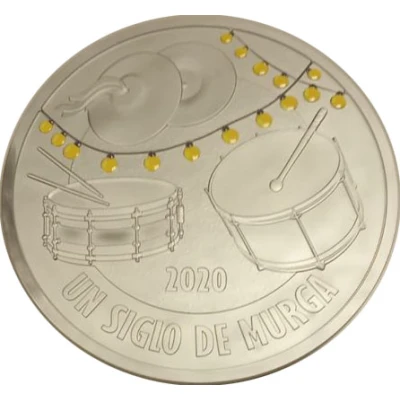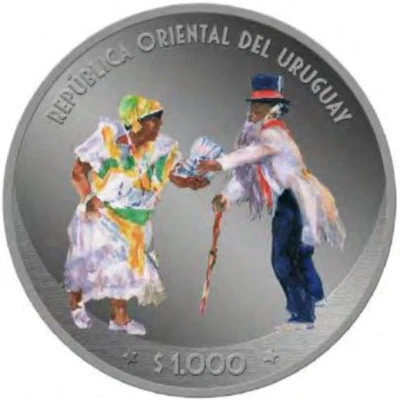
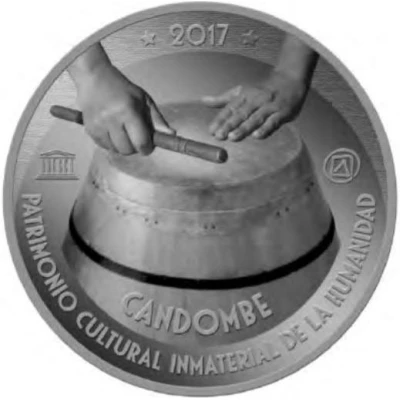

© IUN - Instituto Uruguayo de Numismática
1000 Pesos Uruguayos Candombe
2017 year| Silver (.900) | 12.5 g | 33 mm |
| Issuer | Uruguay |
|---|---|
| Period | Oriental Republic of Uruguay (1825-date) |
| Type | Circulating commemorative coin |
| Year | 2017 |
| Value | 1000 Pesos Uruguayos (1000 UYU) |
| Currency | Peso uruguayo (1993-date) |
| Composition | Silver (.900) |
| Weight | 12.5 g |
| Diameter | 33 mm |
| Shape | Round |
| Technique | Milled, Coloured |
| Demonetized | 5 December 2019 |
| Updated | 2024-10-09 |
| Numista | N#189711 |
|---|---|
| Rarity index | 86% |
Reverse
Image of hands playing a Candombe drum, UNESCO and ICH logos, Curved legend below, date between 5-pointed stars on top, over event name.
Script: Latin
Lettering:
* 2017 *
CANDOMBE
PATRIMONIO CULTURAL INMATERIAL DE LA HUMANIDAD
Translation:
2017
Candombe
Intangible Cultural Heritage of the Humanity
Comment
Candombe is an Uruguayan manifestation, with African roots, has evolved from over 200 years, being a very common practice on most Afro-descendants, and also other ethnics from Uruguay.Is strongly based on playing drums, played with a stick and a bare hand; there are 3 different types named as "chico", "repique" "piano" and "chico", with different tones, from higher to lower.
The bands are named as "Comparsa", where there are many drum players, and different dancers:
"Mama Vieja" (old grandma) and "Gramillero" (Herb man or doctor) represent old people, with traditional costumes;
"Escobero" is a juggler, with a little broom, which balances, rolls and make several tricks with;
There are men with very big flags, that they wave, and others with symbols on long poles, like stars, half-moons, and others.
There are also male and female dancers.
While the most important yearly event on Candombe, the "llamadas" is on February or March (Friday of Carnival week), is very common to have these events any day, and at any place.
The name "llamadas" (callings) comes from the way those events started: a few drummers started walk on the street, playing the drums, and "calling" the neighbors to join the "comparsa". Drummers and dancers joined them, and was very common to reach 300 people on the "comparsa".
Today Candombe has a place in the official carnival contest each year, being stated minimum and max of members, each group must have at least 36 drummers (12 of each type), and 30 dancers, included flagsmen, with a maximum of 150 members.
Is noticeable the reaction of people when they hear the strong sound of 40 or more drums being played together, many people start moving and follow the dance.
This is something that must be experienced to be able to understand.
Interesting fact
The 1000 Pesos Uruguayos (Candombe) 2017 coin from Uruguay features a unique design that reflects the country's cultural heritage. The coin's reverse side depicts a group of people dancing Candombe, a traditional Afro-Uruguayan dance that originated in the 19th century. The dance is characterized by its lively rhythm and colorful costumes, which are reflected in the coin's design. The coin's obverse side features the coat of arms of Uruguay, along with the coin's denomination and year of issue. This coin is a great example of how numismatics can be used to celebrate and preserve cultural traditions.
Price
| Date | Mintage | VG | F | VF | XF | AU | UNC |
|---|---|---|---|---|---|---|---|
| 2017 | 1500 | - | - | - | - | - | - |
Values in the table are based on evaluations by sales realized on Internet platforms. They serve as an indication only for 1000 Pesos Uruguayos (Candombe) 2017 coin.
